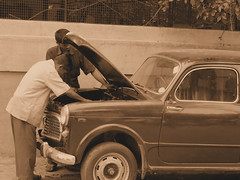
What I know about the innards automobiles I learned from a book on Wankel engines when I was 8. So when my "check engine" light turned on I knew I'd be in for a severe siphoning of money out of my pocket.
Buoyed by my strong sense of miserliness, however, I decided to take a stand and brave the world mechanical. And I'm proud to say I managed to change a broken O2 sensor on my Honda Accord without having to visit a mechanic (or, to be more accurate, watched as my dad changed it, but hey, I was there).
Here's the key trick: all cars built since 1996 have a standard system called OBD-II (On-Board Diagnostics) that monitors much of your car and its health and reports standard codes for any mis-behaving components. There are code readers available from your favorite retailer (here's one from Amazon for $62
Connecting the reader to car is generally easy (it was simply a matter of attaching it to the connector under the steering wheel in the Honda) and you can find explanations for the codes online.
Armed with information about what exactly is wrong with your car you can have a much more … productive conversation with your mechanic.
Or, you can fix it yourself, as we did. Changing the O2 sensor turned out to be surprisingly simple, and not only did I save myself about $300, I also feel extremely proud of myself. I think this is my crowning achievement of 2008. Handy, I am.
Image courtesy of MadMan the Mighty.
